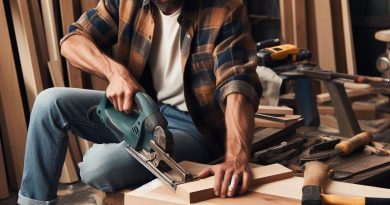Tools of the Trade: Must-Have Gear for Electricians
Last Updated on January 27, 2024
Introduction
A. Importance of Having the Right Tools as an Electrician
In the world of electrical work, success hinges on having the right tools at your fingertips.
The efficiency, safety, and precision of a job often rely on the gear you wield.
B. Topic Introduction: “Tools of the Trade: Must-Have Gear for Electricians”
Enter the realm of skilled craftsmanship with our exploration of indispensable tools for electricians.
From basics to specialized equipment, we unveil the toolkit every electrician should possess.
C. Objective of the Blog Post: Comprehensive List of Essential Tools
Embark on a journey through this blog post designed to be your go-to guide.
We aim to compile an exhaustive list of must-have gear for electricians, ensuring you’re equipped for success in every project.
Basic Hand Tools
Having the right equipment is crucial for an electrician to perform their job effectively and safely.
When it comes to basic hand tools, there are a few must-haves that every electrician needs in their toolbox.
1. Screwdrivers
Screwdrivers are versatile tools that come in handy for a wide range of tasks in the electrical field.
Two specific types of screwdrivers stand out as essential:
- Flathead screwdriver: This classic tool features a flat, narrow tip that is ideal for working with slotted or flathead screws.
- Phillips-head screwdriver: With its cross-shaped tip, the Phillips-head screwdriver is essential for driving and removing screws with a corresponding cross-shaped recess.
Both types of screwdrivers must be durable and made from high-quality materials to withstand the rigors of an electrician’s work.
2. Pliers
Pliers are crucial for any electrician, providing a secure grip and allowing for precise maneuvers.
Two types of pliers that are indispensable for electricians include:
- Needle-nose pliers: These long, slender pliers with pointed jaws are ideal for reaching into confined spaces or manipulating small components.
- Wire-stripping pliers: As the name suggests, these specialized pliers enable electricians to strip insulation from wires without damaging the conductive part.
Electricians should always invest in pliers with comfortable handles to reduce hand fatigue during prolonged use.
3. Wire Cutters
Wire cutters are indispensable for any electrical work involving the cutting of wires.
These specialized cutters make clean and precise cuts, allowing electricians to work efficiently and safely without leaving any sharp edges.
When selecting wire cutters, electricians should consider the gauge and type of wires they typically work with to ensure the cutters are suitable for the task.
To provide high-quality service and ensure the utmost safety, electricians must equip themselves with the right tools.
The basic hand tools mentioned above are just the tip of the iceberg, but they form the foundation of an electrician’s toolkit.
Investing in top-notch screwdrivers, pliers, and wire cutters will not only enhance an electrician’s capabilities but also contribute to their overall professionalism and workmanship.
By having these must-have tools at their disposal, electricians can confidently tackle a wide variety of electrical tasks, whether it’s installing new electrical fixtures, troubleshooting electrical issues, or performing routine maintenance.
Remember, a skilled electrician is only as good as their tools, so it’s essential to invest in high-quality hand tools that withstand the demands of the trade and make the job easier and safer.
Read: Understanding the Role of Electricians in Modern America
Testing and Measuring Tools
1. Voltage Tester
A voltage tester is an essential tool for electricians.
It is used to check the presence of electrical current in a wire or circuit.
This tool helps electricians ensure their safety while working with electricity.
Using a voltage tester is straightforward.
Electricians simply need to touch the lead probes of the tester to the live wire or circuit they want to test.
The tester will then indicate whether there is voltage present or not.
This is important to prevent accidental electrical shock or damage to equipment.
2. Multimeter
Another critical tool in an electrician’s arsenal is a multimeter.
A multimeter combines various functions into one device, such as measuring voltage, current, and resistance.
It is a versatile tool that allows electricians to troubleshoot electrical problems more efficiently.
With a multimeter, electricians can measure the voltage of electrical outlets, test the continuity of wires, and check the resistance of different components.
This helps them identify faulty circuits, locate breaks in wires, and ensure proper electrical flow.
3. Circuit Analyzer
A circuit analyzer is a specialized tool that helps electricians evaluate electrical circuits.
It analyzes various parameters, including voltage, current, frequency, and more.
This tool allows electricians to assess the condition and performance of a circuit accurately.
Electricians use circuit analyzers to identify problems with circuits, such as overload, short circuits, or ground faults.
It provides valuable information on the health of the electrical system, ensuring safety and functionality.
4. Line Splitter
A line splitter is a useful accessory for electricians when testing electrical devices.
It allows them to separate the hot and neutral wires, simplifying the measurement of current draw without interrupting power.
The line splitter consists of two components that clamp onto the hot and neutral wires, creating a safe gap between them.
Electricians can then use their multimeter to measure current or power consumption without the need to disconnect or break the circuit.
5. Tape Measure
While not exclusively an electrical tool, a tape measure is still a must-have for electricians.
Accurate measurements are essential when installing electrical fixtures, planning conduit routes, or positioning electrical boxes.
Electricians use tape measures to determine precise distances, heights, and depths.
This helps them calculate the amount of wiring needed, ensure proper installation, and comply with building codes.
In short, testing and measuring tools play a crucial role in an electrician’s work.
They ensure safety, enable efficient troubleshooting, and provide accurate measurements for precise electrical installations.
Voltage testers, multimeters, circuit analyzers, line splitters, and tape measures are the must-have tools for every electrician to carry out their job effectively and professionally.
Read: Journey to Becoming an Electrician: Steps & Stages
Power Tools
1. Cordless Drill
A cordless drill is an essential tool for every electrician, providing consistent and reliable power.
- Versatility: With multiple speed settings, a cordless drill can handle various tasks, from drilling holes to driving screws.
- Convenience: Being free from cords and cables allows electricians to move freely around job sites.
- Battery Power: Cordless drills come with rechargeable batteries that provide long-lasting performance.
2. Reciprocating Saw
A reciprocating saw is a must-have tool for electricians, offering precision and efficiency.
- Cutting Capabilities: This saw can cut through various materials, including metal, wood, and plastic.
- Accessibility: Its compact size allows electricians to access tight spaces and work in challenging areas.
- Speed and Power: The reciprocating saw delivers high cutting speed and power for quick and clean cuts.
3. Circular Saw
A circular saw is an indispensable tool for electricians, especially when it comes to cutting lumber.
- Accuracy: This saw ensures precise and straight cuts, making it ideal for framing and construction projects.
- Portability: Its compact design allows electricians to easily transport and use it on different job sites.
- Blade Selection: Circular saws have various blade options, making them versatile for different cutting needs.
4. Power Grinder
A power grinder is a valuable tool for electricians, providing the ability to shape and polish materials.
- Material Removal: This tool can remove rust, paint, and other unwanted substances from various surfaces.
- Sharpening Capabilities: Electricians can use a power grinder to sharpen blades and other cutting tools.
- Durability and Power: Power grinders are built to withstand heavy usage and provide high-speed grinding performance.
Basically, power tools are indispensable for electricians, and each tool serves a specific purpose in their trade.
From cordless drills to reciprocating saws, every power tool offers unique features and advantages.
These tools provide electricians with convenience, reliability, and the ability to complete various tasks efficiently.
Whether it’s drilling, cutting, or grinding, power tools play a crucial role in the daily work of electricians.
With the right set of power tools, electricians can enhance their productivity and deliver high-quality results.
Read: Crisis Response: Plumbers in US Natural Disasters and Emergencies

Specialty Tools
1. Conduit Bender
A conduit bender is an essential tool for electricians, allowing them to easily bend conduits and pipes.
With different sizes available, electricians can bend conduits to specific angles based on their project requirements.
This tool ensures precise and accurate bends, preventing any kinks or damage to the conduits.
Conduit benders are typically made of durable materials such as steel or aluminum for long-lasting use.
They often feature markings and charts that assist electricians in achieving the desired bend angle.
2. Fish Tape
A fish tape is another must-have tool for electricians, used for pulling electrical wires through conduits or walls.
It is a flexible, thin, and sturdy long ribbon or tape made of materials like steel or fiberglass.
Electricians attach wires to the end of the tape and use it to navigate through tight spaces and obstacles.
Fish tapes come in various lengths, allowing electricians to work efficiently in different installation scenarios.
They are especially necessary when running new wiring or replacing old wires in existing structures.
3. Crimping Tools
Crimping tools are essential for electricians to create secure and reliable electrical connections in a variety of applications.
These tools use mechanical force to attach connectors and terminals to electrical wires.
By crimping, electricians ensure proper contact, preventing loose connections that can lead to electrical failures or hazards.
There are different types of crimping tools available, including manual, hydraulic, and battery-powered options.
Electricians need to choose the appropriate crimping tool based on the specific connectors and wire sizes they work with.
4. Cable Puller
A cable puller, also known as a cable tugger, is an indispensable tool for electricians involved in cable installation.
It is designed to assist in pulling heavy and long cables through conduits, raceways, or underground trenches.
By using a cable puller, electricians can minimize physical strain and exertion during cable installations.
Cable pullers come in different configurations, including manual, electric, or hydraulic options, depending on the project requirements.
These tools often feature various pulling speeds and pulling force capabilities to handle different cable types and lengths.
Specialty tools for electricians play a crucial role in ensuring efficient and safe electrical installations.
Conduit benders help achieve precise bends, while fish tapes aid in navigating tight spaces.
Crimping tools create secure connections, and cable pullers assist in cable installation without excessive physical strain.
Investing in these must-have tools enables electricians to perform their job with accuracy, confidence, and professionalism.
Read: Overcoming Challenges: Adapting to US Plumbing Innovations
Safety Equipment
A. Insulated Gloves
Electricians need to wear insulated gloves to protect themselves from electric shocks while working with live wires.
These gloves are made of rubber or other materials that can insulate the hands from electrical currents.
Insulated gloves have different voltage ratings, so it’s important to choose the right ones for the job.
Evidence of damage or wear on the gloves means they should be replaced immediately for maximum safety.
Regularly inspecting and caring for insulated gloves is crucial to ensure their effectiveness in preventing electrical accidents.
B. Safety Glasses
Electricians should always wear safety glasses to protect their eyes from flying debris, sparks, and other hazards.
Working with electrical equipment can create a risk of flash-related injuries, which can severely damage the eyes.
Safety glasses should meet the ANSI Z87.1 standard, ensuring they are impact-resistant and provide adequate coverage.
It is essential to clean safety glasses regularly and replace them if they become scratched or damaged.
C. Hard Hat
A hard hat is an essential piece of safety equipment that electricians must wear on job sites.
It protects the head from potential falling objects, low-hanging obstacles, or accidental impacts.
Hard hats should be the type that meets ANSI Z89.1 standards for impact and penetration resistance.
Personalizing hard hats with stickers or paint can weaken their structure and compromise safety.
D. Protective Clothing
Electricians should wear flame-resistant clothing to protect themselves from potential fire hazards.
This includes long-sleeved shirts, long pants, and coveralls made of non-melting materials.
When working in hazardous environments, electricians should also wear arc flash suits for maximum protection.
It is crucial to inspect protective clothing regularly for any damages and replace them as needed.
Electricians should also wear appropriate footwear with slip-resistant and electrically-insulating properties.
In summary, the safety equipment electricians use is of utmost importance to protect themselves from electrical hazards.
Insulated gloves, safety glasses, hard hats, and protective clothing are essential items every electrician should have.
These safety measures help prevent injuries and ensure that electricians can perform their jobs safely and efficiently.
Regular inspection, maintenance, and replacement of safety equipment are necessary to ensure their effectiveness.
By prioritizing safety, electricians can minimize risks and create a safer working environment.
Learn More: Union vs. Non-Union Electricians: What’s the Difference?
Tool Organization and Storage Solutions
- Tool Belt: A tool belt is an essential tool for electricians as it allows them to keep their most commonly used tools easily accessible.
- Tool Bag: A tool bag is another great option for electricians to store their tools.
It is portable and provides multiple compartments for better organization. - Toolbox: A toolbox is an ideal storage solution for electricians who have a large collection of tools.
It helps keep the tools in one place and protects them from damage. - Workbench: A workbench is a must-have for electricians who need to perform tasks requiring a stable surface.
It provides ample space for tools and allows for easy organization.
A. Tool Organization
- Categorize: Start by categorizing your tools based on their usage and size.
This will help you find them quickly when needed. - Sorting: Once you’ve categorized your tools, sort them further by their frequency of use.
Keep the most commonly used tools easily accessible. - Tool Storage System: Invest in a tool storage system that works best for you.
Consider factors such as portability, durability, and organization options. - Tool Tray Inserts: Use tool tray inserts to keep small tools well-organized.
These inserts can be placed in toolboxes or workbenches, providing easy access to tiny tools. - Wall-mounted Storage: Utilize wall-mounted storage solutions such as pegboards or cabinets.
This helps maximize space and keeps your tools visible and easily reachable. - Tool Shadowing: Implement tool shadowing techniques where you outline the shape of each tool on a surface.
This helps identify missing tools instantly and promotes better organization. - Labeling: Labeling is crucial for maintaining an organized tool collection.
Use labels to mark each tool’s place, making it easier to find and return them after use. - Proper Maintenance: Regularly inspect and clean your tools to ensure they perform optimally and last longer.
This also helps in identifying missing or damaged tools.
B. Advantages of Tool Organization
- Time-Saving: With an organized toolkit, electricians can quickly locate the required tools, saving time on each job.
- Enhanced Efficiency: Organized tools eliminate the need to search for specific tools, allowing electricians to focus on their tasks more efficiently.
- Improved Safety: Organized tools reduce the risk of accidents caused by misplaced or lost tools.
Electricians can work with confidence, knowing the tools they need are readily available. - Professional Image: A well-organized toolkit showcases professionalism and competence.
Clients appreciate a tidy workspace, reflecting positively on the electrician’s reputation.
Overall, tool organization and storage solutions are essential for electricians to streamline their work processes and enhance productivity.
Whether it’s using a tool belt for quick access or investing in a toolbox for a comprehensive storage solution, having an organized toolkit contributes to a successful and efficient work environment.
Conclusion
A. Importance of Having the Right Tools
In the dynamic world of electrical work, having the right tools is non-negotiable. It’s the linchpin for efficiency, accuracy, and, most importantly, safety.
B. Key Tools Highlight
Recall the essentials: multimeter, wire strippers, voltage tester, power drill, and insulated gloves.
Each tool serves a crucial role in an electrician’s daily tasks.
C. Encouragement for Quality Tool Investment
Investing in high-quality tools isn’t just a luxury; it’s a safety net and an efficiency booster.
The upfront cost pays off in precision, durability, and enhanced job performance.
D. Reader Engagement
What are your go-to tools? Share your favorites or ask any lingering questions in the comments below.
Let’s build a toolbox of knowledge together!


